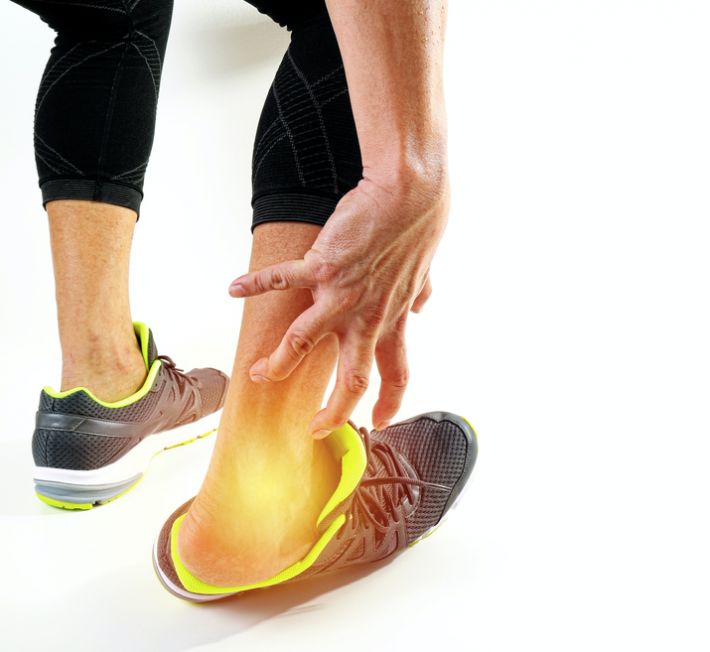
Ankle injuries are some of the most common injuries in sport. They’re especially prevalent in indoor sports like basketball, netball and indoor soccer, but no matter your game, it’s important to be aware of what these injuries are and how they’re treated.
Read below a summary of common ankle and foot injuries. If you’ve got ankle pain or injury, look us up and we’ll be happy to help you rehab and get back to doing what you love.
Low Ankle Sprain
Ankle sprains can be classified as either high or low. Low ankle sprains are more common, and are usually what people think of as a classic ‘rolling your ankle’ type sprain. Commonly seen in volleyball, basketball and soccer, low sprains can involve mild sprains that can keep you from competing for 1-2 weeks, to more severe injuries that may require 4-6 weeks of recovery.
Rehabilitation and Treatment
Diagnosed by a physical exam, low ankle sprains are commonly treated with non-invasive methods such as anti-inflammatories, elevation, taping, ice and bracing. More severe low sprains may require a boot cast or physical therapy. Specific exercises are prescribed to address recovery of mobility, balance and co-ordination, strength and optimised return to sporting activity.
High Ankle Sprain
Less common than low ankle sprains, high ankle sprains are more serious and involve tearing of the ligaments between the ends of the tibia and fibula. The pain involved with these injuries is often felt above your ankle, and often on the lateral side of the joint. They take longer to heal than traditional sprains, and will keep you out of play for longer – potentially 8-10 weeks.
Rehabilitation and Treatment
With a high ankle sprain it’s important to see a doctor, physiotherapist, or even an orthopaedic surgeon for a proper diagnosis. Treatment depends on the severity of injury, and can include ice, anti-inflammatories, rest, and possibly a boot cast similar to a low ankle sprain. Specific exercises are prescribed to address recovery of mobility, balance and coordination, strength and optimised return to sporting activity.
Achilles Tendon Injuries
The achilles is the large tendon connecting the calf muscle to the heel bone. There are two common types of achilles tendon injuries: achilles tendonitis, and achilles rupture. Tendonitis, the less serious injury, often feels like pain behind the ankle joint, swelling, and/or difficulty walking. A rupture is one of the more painful injuries in sports, and is often announced with a popping noise and sharp, stabbing pain.
Rehabilitation and Treatment
Achilles tendonitis is diagnosed with a physical exam and treated with anti-inflammatories, a boot and physiotherapy, which would include a range of specific exercises. Achilles rupture is diagnosed by a doctor or physiotherapist and can be treated conservatively with physio and some cases are considered for a surgical repair at the discretion of the surgeon. With a rupture, it can take six months to a year to return to your sport.
Stress Fractures
A stress fracture is a break in the bone caused by repeated stress. Overuse of muscles and bones from movements like running can cause tiny cracks or micro -fractures to form in foot, ankle or shin bones. These injuries are common in sports with repetitive or prolonged workloads like running, soccer, tennis and basketball. Athletes can hope to return 8 -10 weeks after a stress fracture.
Rehabilitation and Treatment
Stress fractures are diagnosed with a physical exam and confirmed with an MRI scan. An athlete can usually point to the spot of the injury by telling an examiner exactly where the pain is. Because these are overuse injuries, they’re treated with rest and possibly a boot cast for added stability and security.
Rehabilitating Ankle and Foot Injuries
Now you know what the common injuries are, the next most important thing is to remember that proper rehabilitation is critical to recover.
Every injury is unique, every player is unique, and every rehabilitation plan should be custom fitted for best results.
If you want the proper diagnosis, personal attention and care based on extensive experience and knowledge of sport injuries and therapy, contact us at Morley Physiotherapy. We proudly serve Beechboro, Morley and all of Perth’s Eastern Suburbs and beyond.
